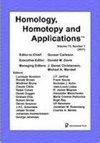A homotopy orbit spectrum for profinite groups
IF 0.5
4区 数学
Q2 MATHEMATICS
引用次数: 0
Abstract
For a profinite group $G$, we define an $S[[G]]$-module to be a certain type of $G$-spectrum $X$ built from an inverse system ${\lbrace X_i \rbrace}_i$ of $G$-spectra, with each $X_i$ naturally a $G/N_i$-spectrum, where $N_i$ is an open normal subgroup and $G \cong \lim_i G/N_i$. We define the homotopy orbit spectrum $X_{hG}$ and its homotopy orbit spectral sequence. We give results about when its $E_2$-term satisfies $E^{p,q}_2 \cong \lim_i H_p (G / N_i , \pi_q (X_i))$. Our main result is that this occurs if ${\lbrace \pi_\ast (X_i) \rbrace}_i$ degreewise consists of compact Hausdorff abelian groups and continuous homomorphisms, with each $G/N_i$ acting continuously on $\pi_q (X_i)$ for all $q$. If $\pi_q (X_i)$ is additionally always profinite, then the $E_2$-term is the continuous homology of $G$ with coefficients in the graded profinite $\widehat{\mathbb{Z}} [[G]]$ module $\pi_\ast (X)$. Other results include theorems about Eilenberg–Mac Lane spectra and about when homotopy orbits preserve weak equivalences.无穷群的同调轨道谱
对于一个无限群 $G$,我们定义 $S[[G]]$ 模块为由 $G$ 谱的反系统 ${lbrace X_i \rbrace}_i$ 建立的某种类型的 $G$ 谱 $X$,每个 $X_i$ 自然是一个 $G/N_i$ 谱,其中 $N_i$ 是一个开放的正则子群,而 $G \cong \lim_i G/N_i$ 是一个开放的正则子群。我们定义了同调轨道谱 $X_{hG}$ 及其同调轨道谱序列。我们给出了当其 $E_2$ 项满足 $E^{p,q}_2 \cong \lim_i H_p (G / N_i , \pi_q (X_i))$ 时的结果。我们的主要结果是,如果 ${\lbrace \pi_\ast (X_i) \rbrace}_i$ 度上由紧凑的豪斯多夫无边际群和连续同态组成,并且每个 $G/N_i$ 对所有 $q$ 连续作用于 $\pi_q (X_i)$ ,那么就会出现这种情况。如果 $\pi_q (X_i)$ 总是无限的,那么 $E_2$ 项就是 $G$ 的连续同调,其系数在分级的无限 $\widehat\{mathbb{Z}} 中。[[G]]$ 模块 $\pi_\ast (X)$.其他结果包括关于艾伦伯格-麦克莱恩谱的定理和关于同调轨道何时保持弱等价性的定理。
本文章由计算机程序翻译,如有差异,请以英文原文为准。
求助全文
约1分钟内获得全文
求助全文
来源期刊
CiteScore
1.10
自引率
0.00%
发文量
37
审稿时长
>12 weeks
期刊介绍:
Homology, Homotopy and Applications is a refereed journal which publishes high-quality papers in the general area of homotopy theory and algebraic topology, as well as applications of the ideas and results in this area. This means applications in the broadest possible sense, i.e. applications to other parts of mathematics such as number theory and algebraic geometry, as well as to areas outside of mathematics, such as computer science, physics, and statistics. Homotopy theory is also intended to be interpreted broadly, including algebraic K-theory, model categories, homotopy theory of varieties, etc. We particularly encourage innovative papers which point the way toward new applications of the subject.

 求助内容:
求助内容: 应助结果提醒方式:
应助结果提醒方式:


